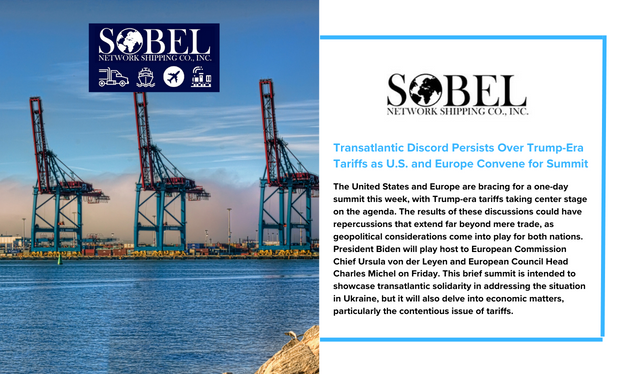The United States and Europe are bracing for a one-day summit this week, with Trump-era tariffs taking center stage on the agenda. The results of these discussions could have repercussions that extend far beyond mere trade, as geopolitical considerations come into play for both nations.
President Biden will play host to European Commission Chief Ursula von der Leyen and European Council Head Charles Michel on Friday. This brief summit is intended to showcase transatlantic solidarity in addressing the situation in Ukraine, but it will also delve into economic matters, particularly the contentious issue of tariffs.
A Wall Street Journal report reveals that the U.S. and Europe remain at odds over the tariffs implemented during the Trump administration, straining their trans-Atlantic relationship. Former President Donald Trump’s imposition of tariffs on U.S. steel and aluminum imports in 2018 led to tensions with American allies and retaliatory measures.
While the U.S. and EU aspire to make headway during the forthcoming summit, reaching a conclusive agreement remains uncertain, potentially extending the tariff dispute into the next presidential election, according to the WSJ article. The issue carries substantial implications for U.S.-EU ties, climate objectives, and global geopolitics.
Initially, the Biden administration permitted European steel and aluminum imports into the U.S. without tariffs, provided that import levels remained below historical thresholds—a gesture to mend relations after tumultuous years under the Trump presidency. This move also prompted the EU to suspend its retaliatory tariffs on various U.S. goods. Nonetheless, economic tensions resurfaced, primarily driven by provisions linked to clean-technology subsidies within the U.S. Inflation Reduction Act (Climate Bill). This development caused certain European businesses to contemplate shifting investments to the U.S. Additionally, some European politicians accused the U.S. of capitalizing on European energy shortages related to the Ukraine conflict by imposing exorbitant prices for liquefied natural gas, which escalated industrial costs.
In the ongoing negotiations, the U.S. seeks EU tariffs on Chinese steel, alleging that it contributes to global oversupply and negatively impacts U.S. producers. Simultaneously, the U.S. exhibits reluctance to completely lift tariffs on European metals, instead pursuing commitments from the EU to impose tariffs on Chinese steel as a trade-off for maintaining the suspension of tariffs on European imports.
The EU’s stance centers on the cessation of U.S. tariffs and an insistence that any trade measures comply with the regulations of the World Trade Organization.
European officials have expressed a willingness to initiate an anti-subsidy investigation into steel originating from non-market economies, yet they resist Washington’s call for specific actions against Chinese products, citing WTO regulations. According to the WSJ article, the EU is reportedly planning to announce this investigation targeting steel during the upcoming summit on Friday, October 20, potentially using it as a bargaining chip in negotiations with the United States.
In conclusion, the outcome of these negotiations will not only reverberate through trade relations but will also exert a more far-reaching impact on the global geopolitical landscape.
Additional Tariffs on the Horizon for China
The Biden administration is gearing up to unveil fresh restrictions on artificial intelligence chips and equipment that can be exported to China, according to administration officials who spoke to Axios. These forthcoming limitations, set to be announced early this week, expand upon the White House’s efforts to thwart China’s pursuit of a military advantage in artificial intelligence.
These controls will also place constraints on the export of equipment utilized in the production of advanced semiconductors, aligning the U.S. with regulations already imposed by Japan and the Netherlands.


